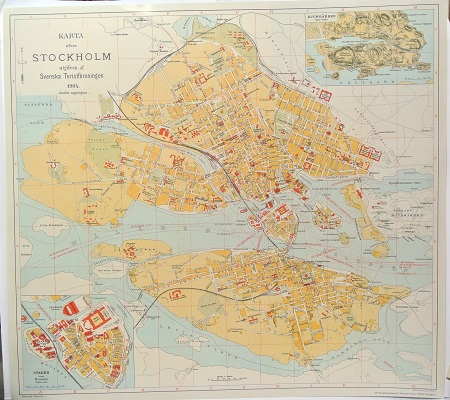1768-1832. Född i Köpenhamn, död i Christiania (Oslo).
Norsk officer. Officer i 'Ingenjörskorpsen'. 1790 kom han till Norge där han tillsammans med kaptenlöjtnant C.F. Grove (se denne) och löjtnant N.A. Wibe (se denne) utförde den första trigonometriska trianguleringen av den norska kusten. Vid avslutandet av detta arbete blev han år 1800 stationerad i Kristiansand som ingenjörsofficer. 1803 blev han kapten och 1810 major och förste direktör för 'Den kombinerade militära och ekonomiska uppmätningen' (senare 'Norges Geografiske Oppmåling'). Denna befattning hade han till den dag han dog. 1815 blev han dessutom chef för Ingenjörskorpsen och år 1818 generalmajor.
N. biogr. leks. - de Seue.
1667-1727.
Engelsk kartograf. 1701 gav han i Oxford ut en atlas med titeln 'New Set of Maps of Ancient and Present Geography'. Den följdes av tre nyutgåvor, den senaste 1726. Hans kartor är mycket schematiska och enkelt ritade men likväl inte helt utan dekorationer.
Bland arbeten.
New Set of Maps of Ancient and Present Geography.
Tooley. Phillips.
1744-1820. Född och död i Stockholm.
Svensk kartograf och friherre. 1770 blev han bergsmästare och 1781 bergsråd. Han gjorde även en förtjänstfull insats som kartograf genom att ta upp en gammal plan om geografisk beskrivning och kartläggning av Sverige och Finland. Verket påbörjades 1795 och avslutades 1818 med totalt 33 kartor med titeln 'Geographiske chartor öfver Swerige i 4 afdelingar'. Det 'Hermelinska kartverket', som är den första svenska rikskartan i atlasform, fick stort erkännande. Arbetet med kartorna försatte honom i svåra ekonomiska omständigheter. Hermelin var medlem av en rad lärda sällskap både i Sverige och utomlands.
Bland arbeten.
Kartor i verket Geographiske chartor.
Finland.
1. Storfurstendömet Finland.
2. Nylands och Tavastehus samt Kymmene-gårds höfdingedömen.
3. Savolax och Karelens eller Kuopio höfdingedömen.
4. Uleåborgs höfdingedöme.
5. Wasa höfdingedöme.
6. Åbo och Björnebergs höfdingedöme med Åland.
Sverige.
1. Swerige med tillgränsande länder.
2. Carlstads höfdingedöme eller Wärmeland. (2 blad).
3. Elfsborgs höfdingedöme.
4. Göta rike eller Södra delen af Sverige.
5. Göteborgs och Bohusläns höfdingedöme.
6. Halmstads höfdingedöme eller Halland.
7. Helsingland och Gestrikland.
8. Herjeådalaen.
9. Jönköpings, Kronobergs och Blekings höfdingedömen.
10. Kalmar höfdingedöme med Öland.
11. Kopparbergs Säters, Näsgårds och Wester bergslags fögderier i St. Kopparbergs höfd.
12. Linköpings höfdingedöme eller Östergötland.
13. Nyköpings höfdingedöme.
14. Skaraborgs höfdingedöme.
15. Skåne eller Malmöhus och Christianstads höfdingedömen. (2 blad).
16. Stockholms höfdingedöme.
17. Stora Kopparbergs höfdingedöme eller Dalarne.
18. Svea rike och Norrland.
19. Upsala höfdingedöme.
20. Westerbotten och Lappmarken, eller Umeå höfdingedöme.
21. Westerås höfdingedöme.
22. Wisby höfdingedöme eller Gottland.
23. Ångermanland, Medelpad och Jämtland eller Wester Norrlands höfdingedöme.
24. Örebro höfdingedöme.
I atlasen ingår även 3 vyer / utsikter.
1. Utsigt af ett Wattenfall i Lappmarken.
2. Utsigt af en Belägenhet i Finland.
3. Utsigt af Stockholm.
Totalt 33 kopparstick.
(Lönborg, s. 193-209. - Sv. män och kv.
Karta öfver Stockholm. - 1904.
Natt och dag, Melampyrum nemorosum - Lindman, C. A. M, Bilder ur Nordens Flora 1917-26.



